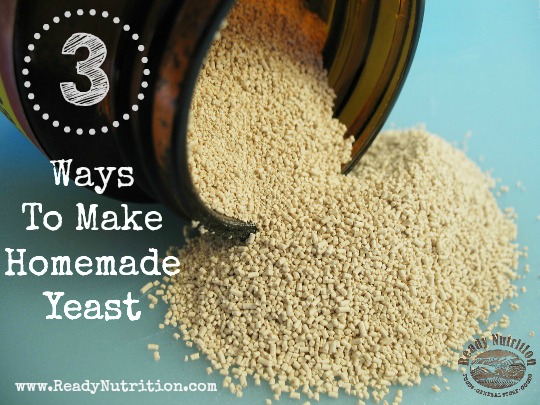Survival Food Series: 3 Ways To Naturally Make Yeast
Where would we be without the discovery of yeast? Fresh, puffy bread would be non-existent, and need I not mention the fact that beer, wine and alcohol products would cease to exist. Of course, all yeasts were not created equal. Some yeasts are made for making bread and baked goods, and some yeasts are made for distilling spirits.
Knowing ways of making this essential prep would be beneficial to anyone trying tolive off of the food supply they have. Grains, vegetables and fruits are three of the easiest ways to find yeast. Some have even used herbs to get their yeast.
How Does It Work?
Did you know that yeast is actually alive on plants? As long as it has warmth, moisture, and food to grow, it will stay alive. Fruits, vegetables, herbs, and all edible sources have yeast living on it’s surface. As a result, using different produce will add to the flavor of the bread you make. Simply by soaking the produce in water, you can separate the yeast and use the water it is floating in. The water and yeast actually start the fermentation process that when mixed with flours creates that desirable baked good we love so much. This fermented concoction is also called a bread starter by some.
By using this method, however much water the recipe calls for is how much water to soak the fruit, vegetable, herb or grain in. Those that have used this method rave about raisins as being one of the best fruits to use for acquiring yeast.
Grains
In the book, The Little House Cookbook, Ma Ingalls explains how she ferments her bread dough using what she has on hand,”You start it by putting some flour and warm water in a jar and letting it stand till it sours…”Then you use it, always a little. And put in the scraps of biscuit dough…and add warm water, and cover it and just set it in a warm place.”
Because yeast is already present on grains, when combined with water, the yeast will separate from the grain. As a result of the soaking process, the combination will begin to ferment.
To create this starter you will need:
- 1 1/4 unbleached all-purpose white flour
- 1 cup of warm water
- Glass jar with lid or piece of cheesecloth
- Mix flour and water in the jar and let stand until the batter bubbles and rises. This may take anywhere from overnight to a week!
Potatoes
Wild yeast naturally lives on potatoes, as well, making this a popular choice for making distilled spirits, such as vodka. According to the article,”Homemade Yeast: Making and Using Yeast For Bread,” the author states that using potatoes to make yeast starters dates back to 4,000 B.C.
Yeast Starter 1
- one medium potato, unpeeled
- 4 cups water
- 1 tsp. sugar
- Boil potato in the unsalted water until done. Drain, but save the water.
- Mash potato then add sugar and salt.
- Cool to lukewarm, add enough potato water to make one quart of mixture.
- Cover and set in a warm place and allow to ferment. Note: If the starter is not rising, you can add a package of store bought yeast to speed up the process (but it will be just as good if allowed to ferment without the added yeast). This recipe is about right for a large family requiring more than one loaf for baking.
Yeast Starter 2
- one potato, unpeeled (about the size of a large hen egg)
- 3/4 cup potato water
- 2 Tbsp. sugar
- flour
- Boil potato, drain and save potato water (unsalted).
- Mash potato well, and then add potato water, sugar and enough flour to make a fairly stiff batter or soft dough.
- Keep in a warm place until fermenting process is complete.
- Put mixture in a wide mouth jar and cover loosely–never use a tight fitting lid. In about five or six days it should be ready.
Fruit Yeasts
Many fruits can be used to make yeast for bread. Oranges, apples, grapefruits, grapes and even dried raisins all have traces of yeast on them. Using yeasts from fruits will create different flavors to the breads that you make. Skins of fruit can be used as well as cores of apples and even tomatoes. The only fruits that should be avoided are kiwi, pineapple and papaya. These fruits contain actinidin, an enzyme that breaks the dough down and it creates a sticky mess.
Fruit Yeast Starter
- 3-4 tbls. raisins (or any fresh or dried fruit)
- bottled water
- clean jar
- Place raisins in clean jar and pour bottled water into the jar until it is 80% full.
- Loosely cover the jar and leave at room temperature. This process should take a few days. You will notice small bubbles and “activity” occurring inside the jar.
- At this point, all the raisins should be floating at the top. The jar should smell like wine. Once it is done, store in the refrigerator.
*Tip: Adding 1-2 tablespoons of honey or sugar to your mixture speeds up the fermenting process and leads to a better result.
Without yeast, our lives would be void of many of our day-to-day products. Getting back to the basics and learning how to make yeast yourself will give you an invaluable skill to hold onto and share with others. Using different produce such as oranges, potatoes, herbs and grains is not only a great science experiment, but a way for you to play around with the flavors of your favorite bread recipes.

No comments:
Post a Comment